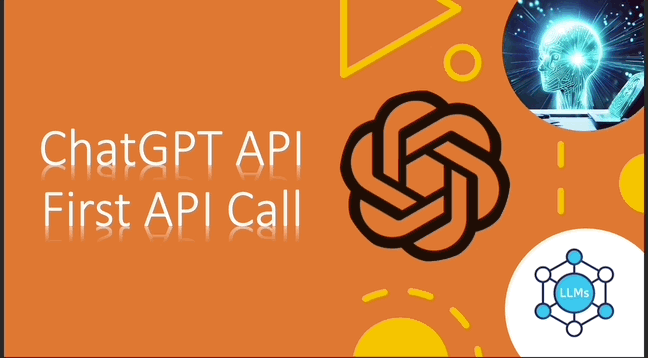
Unlocking Conversations: Your First ChatGPT API Call
Rany ElHousieny, PhD???
Generative AI Engineering Manager | ex-Microsoft | AI Solutions Architect | Expert in LLM, NLP, and AI-Driven Innovation | AI Product Leader
Introduction:
Integrating OpenAI's ChatGPT into your applications opens up a world of interactive and engaging conversational experiences. In this article, we will guide you through your first ChatGPT API call. We'll cover the necessary setup, demonstrate how to make a simple API call, and explore the response it generates. Let's dive in!
f you are new to ChatGPT, start with the following article:
Preparing Your Environment
Install?Python
Visual Studio?Code
Follow the detailed instruction to install VS Code in this article (You can skip Node and Yarn installations, if you are not going to use Node)
Configure VSCode for Python:
Open VSCode and create a new file with extension?.py?
The moment you create the file and click enter, it will ask you to install Pythin Extension. Click install as shown above
Make sure you have the Python interpreter which will show at the bottom
Write a simple print statement
print('Hello ChatGPT')
Run the command by pressing ctrl + F5
This will print “Hello ChaGPT” to the terminal
Steps to acquire API access and obtain necessary credentials:
Making API?Requests
?1. Install openai?Library
For Python
pip3 install openai
For Node.js
npm install openai
2. Authentication
Now we will use the APIKey we obtained in the previous step to Authenticate. Let’s first add it to a variable
secret_key = 'copy and paste your key here'
Here is the simplest code to call the API
secret_key = 'copy and paste your key here'
import openai
# Set up your OpenAI API credentials
openai.api_key = secret_key
# output = openai.Model.list()
output = openai.Completion.create(
model="text-curie-001",
prompt="tel me a joke",
)
print(output)
In the above code, you need to replace secret_key with your actual OpenAI API key, which you can obtain from your OpenAI account. The call_chatgpt function takes a prompt parameter as input, sends an API request to the ChatGPT model using OpenAI's Python library, and returns the generated response.
Note that this example uses the "text-curie-001" model, but you can modify the model variable to use other models as needed. Also, remember to ensure you have the OpenAI Python library (openai) installed before running the code.
领英推荐
Run the program by pressing Run?
The response comes in a JSON Format
{
"id": "cmpl-7ZstBpD71Py3TOF8CC4swmplqhFRT",
"object": "text_completion",
"created": 1688786829,
"model": "text-curie-001",
"choices": [
{
"text": "\n\nWould you like me to tell you a joke? \nNo,",
"index": 0,
"logprobs": null,
"finish_reason": "length"
}
],
"usage": {
"prompt_tokens": 4,
"completion_tokens": 16,
"total_tokens": 20
}
}
The joke is
Would you like me to tell you a joke?
No
Apparently, it is not that funny?:)
Understanding the Response:
Let's break down the response from ChatGPT:
Understanding the response object allows you to extract and utilize the generated text as well as analyze the token usage for billing or other purposes.
This response is a JSON Object. Inside this object, there is a list of objects named "choices"
Let's print out just this list
output_text = output["choices"]
print(output_text)
It will print out the following:
[<OpenAIObject at 0x1055bf810> JSON: {
? "text": "\n\nWhat do you call a shih tzu with a master's degree",
? "index": 0,
? "logprobs": null,
? "finish_reason": "length"
}]
We want to print the text that is in the first object in the list as follows:
output_text = output["choices"][0]
This will print out the following:
{
? "text": "\n\nWhy did the chicken cross the road?\n\nTo get to the",
? "index": 0,
? "logprobs": null,
? "finish_reason": "length"
}
Now let's just print the text response, which we usually get on the ChatGPT:
output_text = output["choices"][0]["text"]
The output will look like this:
What do you call a giraffe with a necktie? A gentleman
Here is the full code
secret_key = "sk-..."
import openai
# Set up your OpenAI API credentials
openai.api_key = secret_key
output = openai.Completion.create(
model="text-curie-001",
prompt="tel me a joke",
)
output_text = output["choices"][0]["text"]
print(output_text)
To get the list of models:
output = openai.Model.list()
Conclusion:
Congratulations on completing your first ChatGPT API call! You have taken the first step towards creating dynamic and interactive conversational experiences powered by OpenAI's language models. By leveraging the ChatGPT API, you can unlock the potential for engaging chatbots, virtual assistants, and more. Remember to experiment, iterate, and explore the possibilities as you integrate ChatGPT into your applications. Enjoy the power of conversation!